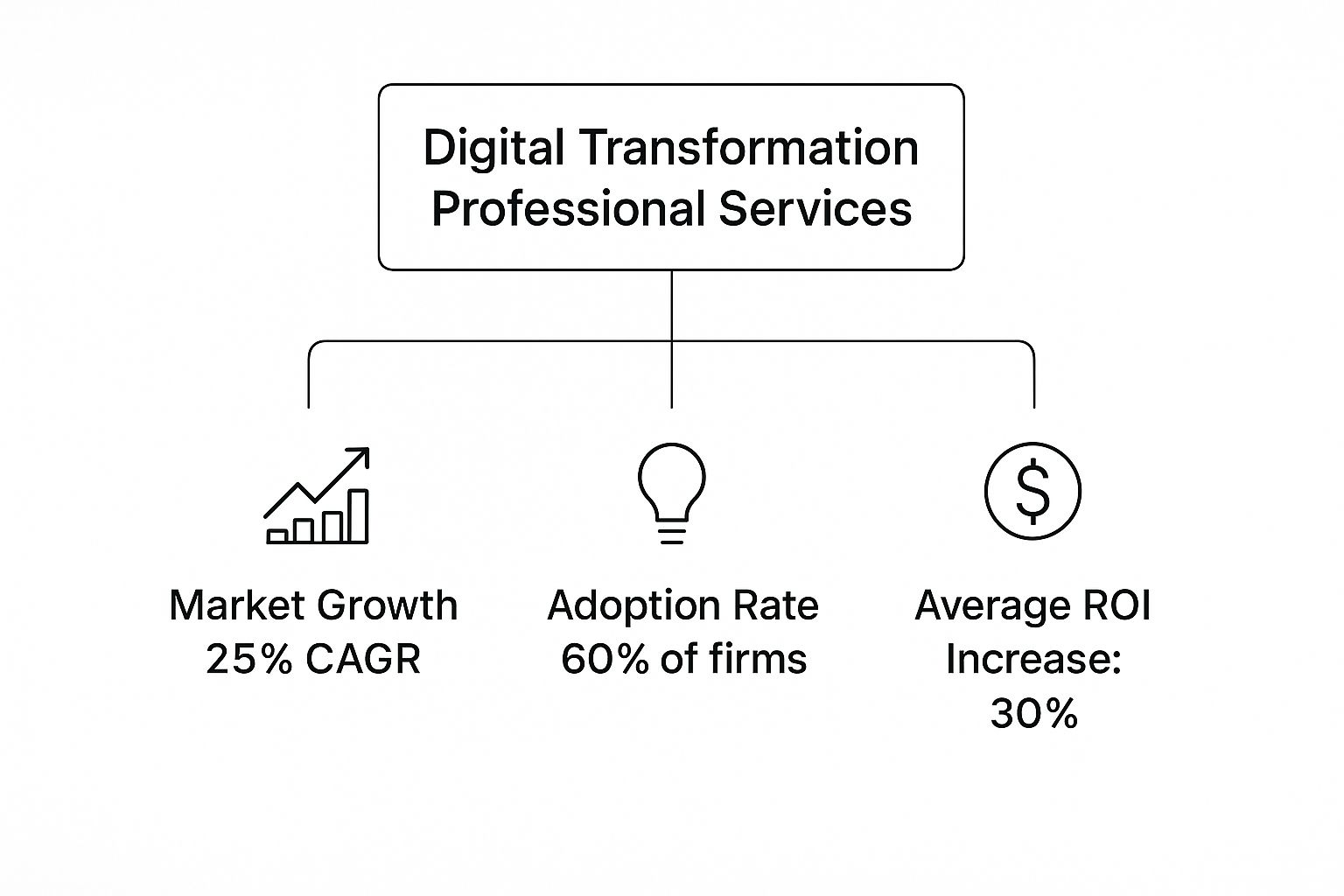In the dynamic world of professional services, digital transformation has evolved from a boardroom buzzword to a fundamental mandate for survival and growth. This isn't just about adopting new software; it's a profound reimagining of how your firm operates, delivers value, and engages with clients. It's about strategically rebuilding your business model for a digital-first reality.
Why Digital Transformation Is Reshaping Professional Services

Think of digital transformation as the strategic evolution of your firm’s culture, workflows, and client relationships. It’s akin to upgrading a traditional library into a smart, predictive information hub that anticipates client needs. Making this leap is critical for competing in a market where client expectations are shaped by the seamless, on-demand experiences they receive everywhere else.
This pressure to adapt is a measurable market reality. A report from Salesforce reveals a dramatic pivot: by 2025, over a third of firms anticipate that 75% or more of their revenue will originate from digital sources. This is a threefold increase from 2019, underscoring the rapid convergence of client demands and firm capabilities. You can explore more about these industry projections to grasp their full implication.
The Core Drivers of Change
This profound shift is propelled by specific pressures and opportunities that directly impact a firm's profitability and long-term viability. Understanding these drivers is the first step in building a compelling business case for investing in digital transformation professional services.
The table below breaks down the key forces at play, connecting each to a concrete business goal and a real-world example.
Key Drivers Compelling Digital Transformation
These drivers all point to a singular conclusion: firms must evolve or risk obsolescence.
Here’s a closer look at what’s compelling this change:
- Sky-High Client Expectations: Today's clients demand instant access to information, personalized communication, and proactive advice. Their standards are set by leading consumer brands, and they bring those same expectations to your firm.
- Crippling Operational Inefficiency: Manual, repetitive tasks and siloed data create frustrating bottlenecks. They inflate costs and, more importantly, prevent your team from focusing on the high-value strategic work clients pay for.
- The Data Imperative: Without collecting, analyzing, and acting on data, you are operating with a blindfold. Competitors are leveraging data insights to refine their services, identify market trends, and win your clients.
Embracing transformation means moving from a reactive service model to a proactive, value-driven partnership. It’s about using technology not just to do the same things faster, but to do entirely new things that were previously impossible.
Ultimately, this evolution is about building resilience. By weaving modern tools and smarter processes into the fabric of your firm, you become more agile, data-informed, and client-focused—positioning you to thrive through whatever comes next.
The 4 Pillars of a Modern Transformation Strategy
Embarking on a full-scale digital transformation can feel overwhelming. To create clarity and provide direction, anchor your strategy in four foundational pillars. These interconnected elements provide a clear roadmap for any professional services firm committed to modernizing its operations.
The infographic below highlights why this is so critical, showcasing the significant growth, high adoption rates, and strong ROI that firms are achieving from their transformation efforts.

The data confirms this is not just a trend; it's a strategic business move with a quantifiable financial upside.
1. Reinventing the Client Experience
The first pillar requires a fundamental shift in mindset: you're not just delivering a service; you're orchestrating an entire client journey. Today's clients expect the same frictionless, on-demand experience from their law firm or accounting partner that they get from their favorite retail brands.
This means building a digital ecosystem where clients feel heard, informed, and in control. A law firm, for instance, can offer a secure client portal to track case status, upload documents, and message their legal team anytime. This enhances client satisfaction while simultaneously reducing the administrative burden on your team.
Key initiatives often include:
- Self-Service Portals: Giving clients direct access to their information and the ability to handle simple tasks themselves.
- Personalized Communication: Using CRM data to send advice and updates that are genuinely relevant and timely.
- Digital Onboarding: Creating a seamless, paperless process for new clients to make a powerful first impression.
2. Achieving Operational Excellence Through Automation
This second pillar turns the focus inward to your firm's operational engine. Many professional services firms are encumbered by outdated processes, manual data entry, and repetitive administrative work. These inefficiencies consume valuable hours that experts could otherwise dedicate to high-value client strategy.
Operational excellence is about systematically identifying these bottlenecks and applying intelligent automation. An accounting firm can automate complex compliance checks, data reconciliation, and invoicing, which not only accelerates processes but also significantly reduces human error. The objective is clear: free your best people from routine tasks so they can focus on providing expert advice.
By automating the mundane, you unlock the brilliant. This isn't about replacing your people. It's about augmenting their skills and amplifying their impact.
3. Making Decisions with Data-Driven Marketing, Not Gut Instinct
Data is the new strategic asset, but its collection is only half the equation. This third pillar is about transitioning from a firm that merely possesses information to one that uses it for foresight. It’s about developing the capability to turn vast reserves of client, project, and financial data into a powerful decision-making tool.
This requires more than just new analytics software; it demands a cultural shift toward evidence-based decision-making. For example, a consulting firm can analyze project data to identify its most profitable service lines or determine which client profiles have the highest retention rates. Such insights allow leaders to allocate resources more effectively.
This pillar helps you answer critical business questions:
- Which clients are exhibiting churn risk?
- Where are our largest untapped growth opportunities?
- How can we price our services more intelligently?
4. Building an Empowered and Agile Workforce
Ultimately, technology is only as effective as the people who use it. This final pillar—arguably the most critical—is centered on your team. A successful transformation requires a workforce that is not only equipped with the right tools but also culturally prepared to adapt, learn, and innovate.
This involves fostering a culture of continuous learning where team members are encouraged to develop new digital skills. It also means adopting agile methodologies so teams can pivot quickly in response to changing client needs and market conditions. Provide collaborative platforms, offer ongoing training, and articulate the "why" behind the changes.
When your team feels confident and empowered by new technology, they transition from passive observers to active drivers of transformation. They will discover innovative ways to use the tools, sparking innovation from the ground up and ensuring the changes are sustainable.
How to Navigate Common Transformation Hurdles

While the benefits of modernization are clear, the path to achieving them is rarely without obstacles. Anticipating these common hurdles allows you to build a resilient strategy that can withstand challenges.
These challenges are often more about culture and people than technology. By identifying them early, you can integrate solutions directly into your project plan, turning potential roadblocks into manageable tasks.
Integrating New Tech with Old Systems
A primary challenge is integrating new software with legacy systems that have been in use for decades. This friction between old and new is a classic source of project delays and budget overruns. The solution isn't to rip and replace everything at once. A phased rollout is a far more strategic approach. Start with a single high-impact process and use modern integration tools or APIs to create a stable bridge between legacy and new systems.
Key Insight: Successful integration is an evolution, not a revolution. Build smart connections that allow new and old technologies to coexist while you strategically upgrade core systems over time.
Overcoming Cultural Resistance to Change
Technology is often the easy part; people are the hard part. The most significant obstacle to transformation is frequently cultural resistance. Your team is accustomed to existing workflows, and the prospect of learning new systems can feel overwhelming or even threatening.
A robust change management program is essential to get ahead of this. This means:
- Explain the 'Why' for Them: Articulate how these changes will improve their daily work, such as eliminating tedious data entry, not just how they benefit the firm's bottom line.
- Identify Your Champions: Empower respected team members who are enthusiastic about the new tools to act as advocates and provide peer-to-peer support.
- Invest in Effective Training: Provide comprehensive training to ensure your team feels confident and competent with new systems. For instance, our guide on mastering Salesforce provides practical tips that can help professionals get comfortable with a new CRM.
Closing the Digital Skills Gap and Ensuring Security
Introducing sophisticated new tools creates a demand for new skills. Many firms discover a significant digital skills gap mid-project, realizing their teams lack the expertise to manage and optimize the new technology. Simultaneously, increased connectivity and data collection introduce new cybersecurity risks.
Address both issues in tandem. Commit to upskilling and reskilling your current team through targeted training programs. Concurrently, prioritize robust data security from day one by implementing multi-factor authentication, conducting regular security audits, and establishing clear data governance policies. These intertwined efforts create a digital environment that is both capable and secure.
Despite these hurdles, the momentum for digital transformation in professional services is undeniable, with the industry projected to grow at a 4.8% rate. Yet, a striking 70% of firms feel they are falling behind. Accounting firms appear to be leading the charge with 62% actively transforming, followed by technology services at 53%. You can read more about these professional services transformation trends to see how different sectors compare.
The Game-Changing Role of AI in Professional Services
Artificial Intelligence has transitioned from a futuristic concept to a practical engine driving change in professional services. This isn't about replacing human experts; it’s about augmenting them with intelligent systems that can automate tedious work and uncover insights from vast datasets.
For any firm undergoing a digital overhaul, AI represents one of the most significant opportunities to build a sustainable competitive advantage. Integrating AI into digital transformation professional services is fundamentally reshaping value delivery. We're moving beyond simple efficiency gains into a new era of enhanced quality and deeper service.
Practical Applications of AI in Service Delivery
The impact of AI is most evident in its on-the-ground applications. Generative AI, for example, can produce the first draft of a client report, summarize extensive legal documents, or generate initial marketing copy in minutes. This frees top talent to concentrate on high-level strategy and client relationship building.
Predictive analytics is another area where AI excels. By analyzing historical client data, an accounting firm can forecast which clients are at risk of churn, enabling proactive intervention. Similarly, machine learning algorithms can analyze a firm's project history to identify its most profitable service lines or opportunities for cross-selling.
Key Takeaway: The goal of AI isn't to replace your seasoned professionals. It's to amplify their expertise. Let machines handle the repetitive, data-intensive tasks so your people can focus on strategic thinking, creative problem-solving, and earning client trust.
Real-World AI Scenarios for Professional Firms
Let’s examine a few concrete examples where AI is already delivering value:
- For a Consulting Firm: AI tools can analyze market data, competitor reports, and economic forecasts to produce data-rich strategic plans in a fraction of the time, allowing consultants to deliver deeper insights more quickly.
- For an Accounting Firm: Machine learning can automate the categorization of transactions and identify anomalies during an audit, accelerating workflows and reducing the potential for human error.
- For a Law Firm: AI-powered document review software can scan thousands of legal contracts to find specific clauses or flag potential risks, a task that once required extensive manual effort.
The Critical Need for AI Governance and Ethics
With this power comes immense responsibility. As you integrate AI into your operations, establishing a strong framework for governance and ethics is non-negotiable. Deploying AI without clear rules of engagement can lead to reputational damage and legal complications.
Three areas demand immediate focus:
- Data Privacy: AI systems are data-driven, and in professional services, this often involves sensitive client information. You need ironclad protocols to ensure data is anonymized, secured, and handled in full compliance with regulations like GDPR.
- Algorithmic Bias: An AI is only as unbiased as the data it’s trained on. If historical data reflects past biases, an AI tool could perpetuate them. Firms must actively audit their algorithms to ensure fairness and equity.
- Human Oversight: A human must always remain in the loop. AI can provide powerful analysis and recommendations, but the final decision should always rest with a qualified professional who can apply context, ethics, and nuanced judgment. This human-centric approach is essential for maintaining client trust.
Building Your Actionable Implementation Roadmap
A brilliant strategy is only as good as its execution. This requires a clear, actionable roadmap to guide your firm from its current state to its desired future. This plan is what transforms abstract goals into a concrete project.
Crafting this roadmap is a core function of digital transformation professional services. It's the essential bridge between ambition and tangible results, ensuring every initiative, budget dollar, and team effort is aligned with your firm's overarching goals.
Phase 1: Assessment and Vision Setting
Before charting a course, you must understand your starting point. This initial phase involves an honest self-assessment of your firm's digital maturity across technology, processes, people's skills, and client interactions.
A thorough assessment provides the baseline data needed to build a realistic plan. Without it, you risk setting goals that are either too timid to make a real difference or too ambitious to be achievable. Once you have a clear picture of your current state, you can define a compelling vision for the future—one that is specific, measurable, and directly tied to business outcomes.
Key Insight: Frame your vision not just as a technical goal but as a powerful narrative that illustrates how the transformation will improve your firm’s resilience, client relationships, and competitive edge.
Phase 2: Strategic Planning and Prioritization
With a clear vision, the next step is to break it down into manageable, high-impact initiatives. Not all transformation projects are created equal, and prioritization is key. Start with pilot projects that are high-visibility and have a strong likelihood of success. These early wins build momentum and generate buy-in for more ambitious undertakings.
Use a simple matrix to evaluate potential projects based on their business impact and implementation complexity. This helps you focus on the “quick wins” that deliver immediate value while also mapping out a long-term sequence for more complex initiatives.
Phase 3: Agile Implementation and Technology Selection
The days of multi-year, “big bang” technology rollouts are over. An agile implementation approach, characterized by iterative cycles of development, testing, and refinement, is far more effective. This allows your firm to adapt to challenges and incorporate feedback from your team and clients along the way.
When selecting technology, prioritize solutions that are scalable, secure, and integrate well with your existing systems. Avoid getting locked into proprietary platforms that limit your future flexibility. Instead, look for cloud-based solutions with robust APIs that can grow and adapt with your firm.
Phase 4: Scaling and Continuous Improvement
Once a pilot project has proven successful, the final phase is to standardize the new process and scale it across the organization. This involves creating clear documentation, providing ongoing training, and establishing a governance structure to manage the new systems.
But transformation is not a one-time event. The most successful firms cultivate a culture of continuous improvement, where they are constantly seeking new ways to innovate and optimize. Establish feedback loops, monitor key performance indicators, and empower your team to experiment with new ideas. This ensures that your digital transformation is not just a project but a permanent evolution of your firm’s DNA.





